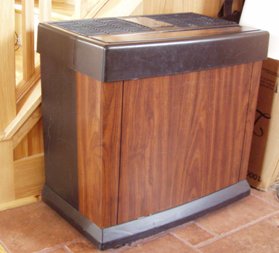 One of the things the DH and I did this year, was look at our heating situation. We have an old oil furnace at Chez Siberia and even without the issue of ‘buying foreign oil’, the thing is old. But replacing it would not change several issues involved with furnaces in houses:
One of the things the DH and I did this year, was look at our heating situation. We have an old oil furnace at Chez Siberia and even without the issue of ‘buying foreign oil’, the thing is old. But replacing it would not change several issues involved with furnaces in houses:
1) They are all electric started so when we lost our power in the winter time, we also lost the heat.
2) Replacing it with a more efficient oil furnace would only make our burning foreign oil even more efficient. Cleaner, but still foreign.
So, we replaced our major source of heat in the house with a wood pellet stove in the living room with the oil furnace as a back up in case the weather got so horribly cold that we could not keep the house warm enough.
The is just one problem with wood heat – it’s dry. Really really dry. Like dries out your nose and your skin and makes you cough and gives you winter itch dry. So, we needed a source of moisture.
As some of you know, the DH and I have used racks over the floor furnace forced air vents to dry clothes in the winter time; as a source of moisture, it works really well, but we no longer have floor vents that are in operation except when the weather is really cold and we turn on the furnace. So, we were looking at humidifiers when one of the big ones at my office died and they were going to just throw it in the dumpster.
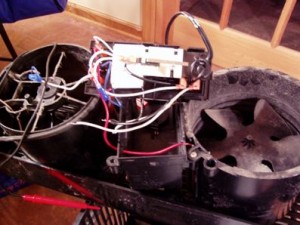 I looked at it; the power lights were on but the fans did not work. Which meant that something was not working between where the power came in and whatever was controlling the fans.
I looked at it; the power lights were on but the fans did not work. Which meant that something was not working between where the power came in and whatever was controlling the fans.
(Warning: Be aware that working with electrical appliances takes care; when testing individual components with a voltage tester, the tester leads were touching the components at all times to determine if power was going through; no one should ever use allow any part of their body to touch electrical sources)
This humidifier has two rheostat sorts of switches – one which says Humidity on it and one which says Fan Speed on it. The fan speed switch was the culprit, the DH found by using an voltage tester on it. As you can see from this photo (and I’m sorry that the labeling is not coming out very well; the call out on the right is indicating the black electrical power lead which comes INTO the switch. The call out on the left indicates the blue and red leads which go out of the switch to the fans. The switch controls the amount of power going to the fans and thereby controls the fan speed. Because the switch is buggered in some way, no power was getting to the fans at all. 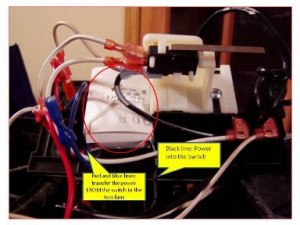
The switch itself consisted of the outer knob which is attached to a soldered circuit card with power leads attached. This is what the switch actually looks like when you get it out of the little box. At the top of the photo, you can see the black power lead coming into the circuit board; the blue and red leads which went to the fans are at the bottom. The every-trusty DH’s hand is holding the actual knob which was used to set the fan speed.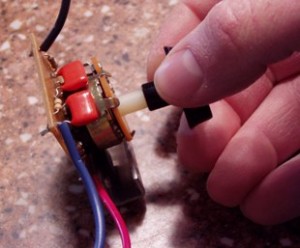
First, we went to our local appliance parts supply store with the model number of the humidifier and the actual switch and the little box sort of thing it was housed in because that had all sorts of labels on it that we thought the appliance guy would find useful. No luck – the humidifier is not being made any longer and the manufacturer which made the actual part is no longer making that part and there is no substitute, according to the clerk’s database (Now, I’m going to go out on a limb here and say that IMHO, there has to be someone out there who is making this sort of thing – I think the clerk in the parts place was not knowledgeable enough to look at the item, identify it in terms of what it was – “oh, that’s a 2 amp rheostat umpty ump,” and find us another one – he only knew enough to look at the database that said ‘no sub’ on it).
So, we were dead in the water. We could not replace that part.
Try strategy number two: Figure out what the switch actually did in the system and see if we could figure out a work-around. By using his tester, the DH figured out that the switch was really the gatekeeper for the power going to the fans, so we decided to ‘hot wire’ the thing so that there was a direct connection between the power supply (the plug in the wall) and the fans themselves. We did not particularly care how much humidity there was; just that there was humidity, which meant that if the fans ran, that is what we’d get. So, the DH fastened the black power line directly to the red and blue lines going to the fans under an electrical screw nut (see photograph). 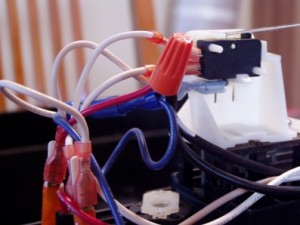
This is NOT an elegant solution. I don’t even know if my high school physics teacher would OK it. And the way we control this thing is: plug in the wall/the fans work; plug out of the wall/the fans don’t work. Pretty crude.
But we do have a big humidifier now (that thing has two bottles that are probably two gallons apiece) that we use when we are in the house and it kept another piece of electrical appliance stuff out of the landfill.
And seriously, the only tools it took to do this job were:
A Phillips head screw driver
A voltage tester
Wire cutters
Electric nut
and some time.
Now, I realize that a voltage tester is not necessarily in every apartment or house tool box, but it’s definitely worthwhile to have one and learn how to use it and learn what you can use it FOR. In this case, by attaching the leads to the power and then to various parts of the humidifier, the DH was able to determine that a) the motors attached to the fans actually worked (thus eliminating the fans as the culprits in the case), and that b) the switch which controlled the power going to the motors on the fans was the ‘fan speed’ switch and that was the gatekeeper that was broken. Again, once you have identified where the issue is, then the solution can be very simple: Either replace (if the part is still made or if there is a substitute) or do a work around.
Yes, you CAN do things like this.
